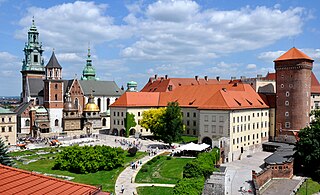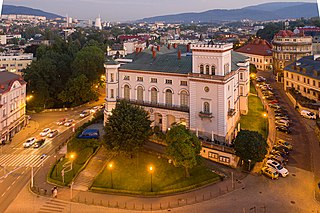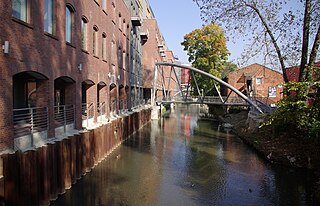
Silesian Voivodeship or Silesia Province is a voivodeship, or province, in southern Poland centered on the historic region known as Upper Silesia, with Katowice serving as its capital.

The European bison or the European wood bison, also known as the wisent, the zubr, or sometimes colloquially as the European buffalo, is a European species of bison. It is one of two extant species of bison, alongside the American bison. The European bison is the heaviest wild land animal in Europe, and individuals in the past may have been even larger than their modern-day descendants. During late antiquity and the Middle Ages, bison became extinct in much of Europe and Asia, surviving into the 20th century only in northern-central Europe and the northern Caucasus Mountains. During the early years of the 20th century, bison were hunted to extinction in the wild.

The environmental movement, is a social movement that aims to protect the natural world from harmful environmental practices in order to create sustainable living. Environmentalists advocate the just and sustainable management of resources and stewardship of the environment through changes in public policy and individual behavior. In its recognition of humanity as a participant in ecosystems, the movement is centered on ecology, health, and human rights.

Bielsko-Biała is a city in southern Poland, with a population of approximately 166,765 as of December 2022, making it the 22nd largest city in Poland, and an area of 124.51 km2 (48.07 sq mi). It is the core of the broader metropolitan area with around 335,000 inhabitants. It serves as the seat of the Bielsko County, Euroregion Beskydy, Roman Catholic Diocese of Bielsko–Żywiec and the Evangelical Church Diocese of Cieszyn.

A nature reserve is a protected area of importance for flora, fauna, or features of geological or other special interest, which is reserved and managed for purposes of conservation and to provide special opportunities for study or research. They may be designated by government institutions in some countries, or by private landowners, such as charities and research institutions. Nature reserves fall into different IUCN categories depending on the level of protection afforded by local laws. Normally it is more strictly protected than a nature park. Various jurisdictions may use other terminology, such as ecological protection area or private protected area in legislation and in official titles of the reserves.

Poland is a part of the global tourism market with constantly increasing number of visitors. Tourism in Poland contributes to the country's overall economy. The most popular cities are Kraków, Warsaw, Wrocław, Gdańsk, Poznań, Szczecin, Lublin, Toruń, Zakopane, the Salt Mine in Wieliczka and the historic site of Auschwitz – a German Nazi concentration camp in Oświęcim. The best recreational destinations include Poland's Masurian Lake District, Baltic Sea coast, Tatra Mountains, Sudetes and Białowieża Forest. Poland's main tourist offers consist of sightseeing within cities, historical monuments, natural monuments, business trips, agrotourism, bicycle touring, qualified tourism, mountain hiking (trekking) and climbing among others.

Białowieża Forest is a forest on the border between Belarus and Poland. It is one of the last and largest remaining parts of the immense primeval forest that once stretched across the European Plain. The forest is home to 800 European bison, Europe's heaviest land animal. UNESCO's Man and the Biosphere Programme designated the Polish Biosphere Reserve Białowieża in 1976 and the Belarusian Biosphere Reserve Biełavieskaja pušča in 1993.

National parks of Canada are protected natural spaces throughout the country that represent distinct geographical regions of the nation. Under the administration of Parks Canada, a government branch, national parks allow for public enjoyment without compromising the area for future generations, including the management of Canadian wildlife and habitat within the ecosystems of the park. Within Parks Canada's administration is a wide range of protected areas, encompassing National Historic Sites, National Marine Conservation Areas (NMCA), and national park reserves.

Białowieża in Poland's Podlasie Province, in the middle of the Białowieża Forest, to which it gave its name. The village is some 21 kilometres (13 mi) east of Hajnówka and 66 km (41 mi) southeast of the province capital, Białystok.

The National Wilderness Preservation System (NWPS) of the United States protects federally managed wilderness areas designated for preservation in their natural condition. Activity on formally designated wilderness areas is coordinated by the National Wilderness Preservation System. Wilderness areas are managed by four federal land management agencies: the National Park Service, the U.S. Forest Service, the U.S. Fish and Wildlife Service, and the Bureau of Land Management.

Jizera Mountains, or Izera Mountains, are part of the Western Sudetes on the border between the Czech Republic and Poland. The range got its name from the Jizera River, which rises at the southern base of the Smrk massif. The beech forests within the Jizera Mountains were added to the UNESCO World Heritage Site known as Ancient and Primeval Beech Forests of the Carpathians and Other Regions of Europe, because of their outstanding preservation and testimony to the ecological history of Europe since the Last Glacial Period.

The Bielsko-Biała Museum, also known as the Castle of the Sułkowski Princes is a museum for the city of Bielsko-Biała, Poland located in the historical Bielsko Castle. Three local branches of the museum have been established since the 1970s: the Julian Fałat Museum, the Museum of Technology and Textile Industry, and the Weaver's House Museum.
A nature park, or sometimes natural park, is a designation for a protected natural area by means of long-term land planning, sustainable resource management and limitation of agricultural and real estate developments. These valuable landscapes are preserved in their present ecological state and promoted for ecotourism purposes.

Białowieża National Park is a national park in Podlaskie Voivodeship, in Eastern Poland adjacent with the border with Belarus. The total area of the park is 105.2 square kilometres (40.6 sq mi). It is located 62 km (39 mi) southeast of Białystok (Poland). It is known for the protection of the best preserved part of the Białowieża Forest, Europe's last temperate primaeval forest fragment that once allegedly stretched across the European Plain. It is home to the world's largest population of European bison, the continent's heaviest land animals. The border between the two countries runs through the forest, the Belovezhskaya Pushcha National Park is adjacent on the Belarus side of the border. There is a border crossing for hikers and cyclists within the forest. According to one study, the park brings in tourist revenues of about 72 million zloty per year.

Biała is a river in southern Poland, a right tributary of the Vistula, around 29 km (18 mi) long. It is the main river of the city of Bielsko-Biała and used to be historically important as a border river dividing not only Bielsko and Biała but also for several centuries the states of Bohemia and Poland.

Protected areas of Poland include the following categories, as defined by the Act on Protection of Nature of 16 April 2004, by the Polish Parliament:
The Youghiogheny Scenic & Wild River is a river given special protected status by the state of Maryland. This wild and scenic portion of the Youghiogheny River is located in Western Garrett County, in Western Maryland. The Yough drains an area comprising approximately 397 square miles (1,030 km2) in Maryland, flowing through forests and farms. It rises from the west side of Backbone Mountain in Preston County, West Virginia, near the state's border with Garrett County.
Scenic Hudson is a non-profit environmental organization in New York that was founded in 1963 to oppose a hydro-electric power project in New York.

The Central European mixed forests ecoregion is a temperate hardwood forest covering much of northeastern Europe, from Germany to Russia. The area is only about one-third forested, with pressure from human agriculture leaving the rest in a patchwork of traditional pasture, meadows, wetlands. The ecoregion is in the temperate broadleaf and mixed forest biome, and the Palearctic realm, with a Humid Continental climate. It covers 731,154 km2 (282,300 sq mi).














